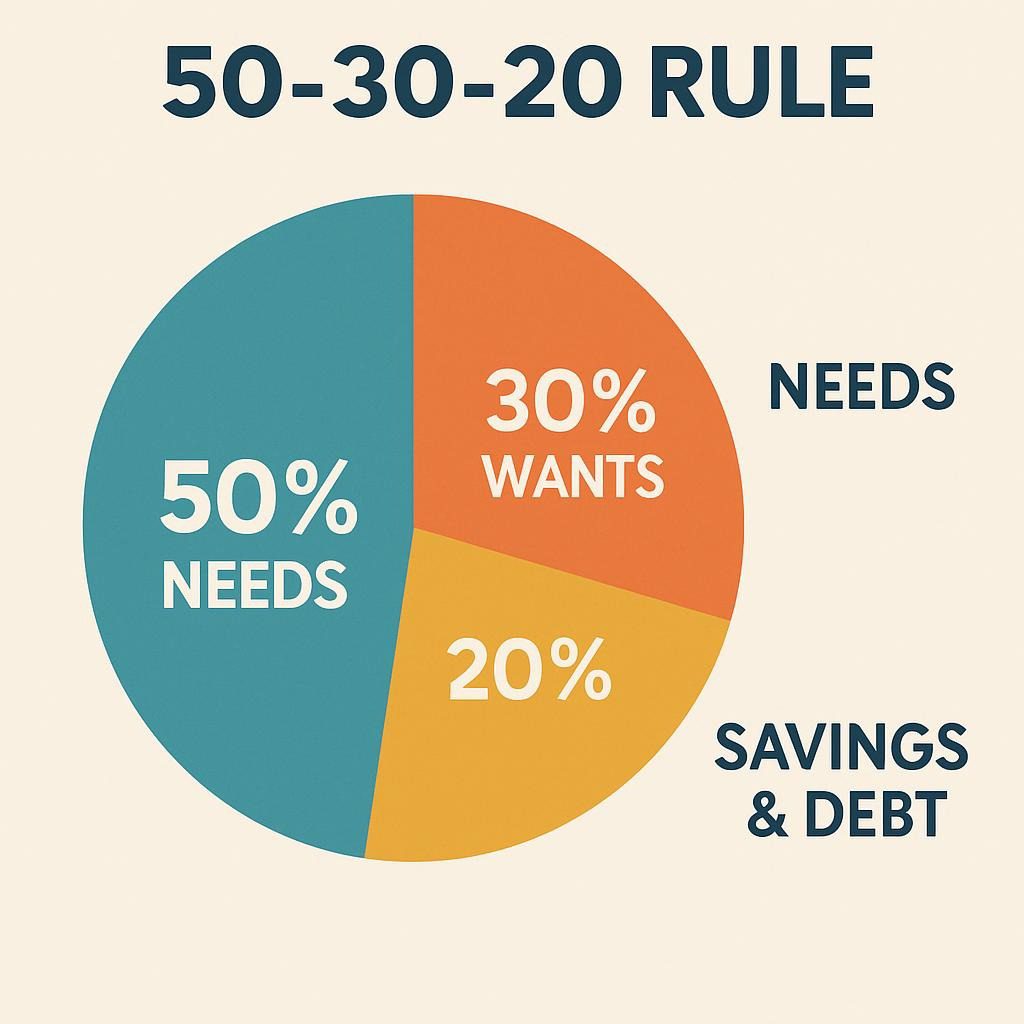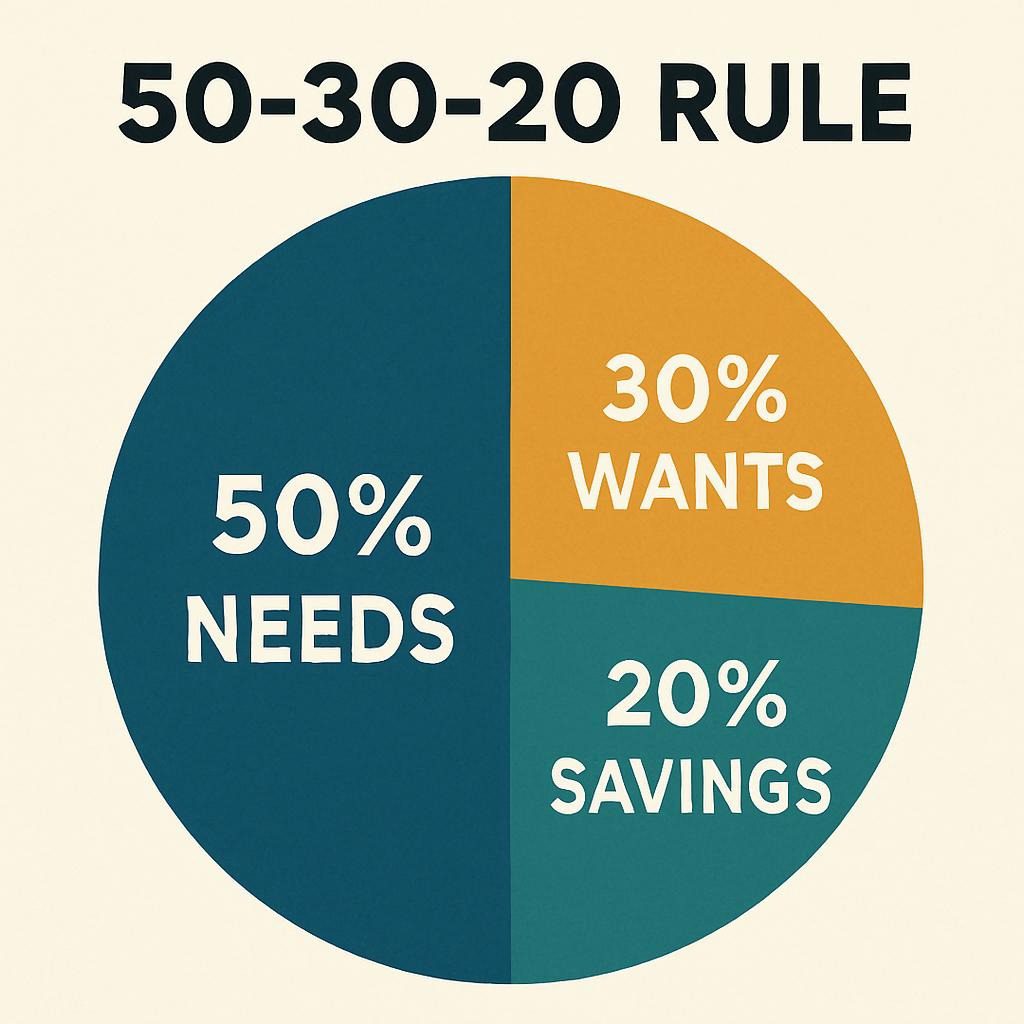The 50-30-20 Rule: Why It Works & How to Master It
The 50-30-20 Rule
Are you uninterested in dwelling paycheck to paycheck? Do you wrestle to save cash regardless of incomes a good revenue? In that case, you are not alone. In line with a 2023 survey by Bankrate, 57% of Individuals cannot afford a $1,000 emergency expense. The excellent news? There is a easy, confirmed budgeting methodology that has helped tens of millions of individuals take management of their funds: the 50-30-20 rule.
This simple budgeting framework, popularized by Senator Elizabeth Warren in her ebook “All Your Price,” affords a transparent roadmap for managing your cash with out the complexity of monitoring each penny. Whether or not you are a budgeting newbie or somebody seeking to simplify your monetary life, the 50-30-20 rule offers a balanced method that prioritizes each your speedy wants and long-term monetary safety.
On this complete information, we’ll discover why the 50-30-20 rule works so successfully, how you can implement it step-by-step, and the methods it’s essential grasp this highly effective budgeting system. By the tip of this text, you will have all of the instruments essential to remodel your monetary habits and construct lasting wealth.
What’s the 50-30-20 Rule?

The 50-30-20 rule is a budgeting methodology that divides your after-tax revenue into three distinct classes:
- 50% for Wants: Important bills you’ll be able to’t keep away from
- 30% for Desires: Discretionary spending for enjoyment and life-style
- 20% for Financial savings and Debt Reimbursement: Constructing your monetary future
This rule creates a balanced method to cash administration that ensures you cowl your primary dwelling bills whereas nonetheless having fun with life and securing your monetary future. In contrast to restrictive budgets that may really feel overwhelming, the 50-30-20 rule offers flexibility inside construction.
The Origin and Philosophy Behind the Rule
Elizabeth Warren, alongside along with her daughter Amelia Warren Tyagi, developed this rule based mostly on a long time of analysis into American spending habits and chapter patterns. They found that households who adopted this primary allocation have been considerably much less more likely to expertise monetary misery.
The philosophy is straightforward: by routinely allocating your revenue into these three buckets, you create a sustainable monetary system that does not require fixed decision-making or detailed expense monitoring. It is designed for actual folks with actual lives who need monetary stability with out changing into monetary analysts.
Why the 50-30-20 Rule Works So Successfully
1. Psychological Advantages
The 50-30-20 rule succeeds the place many budgets fail as a result of it acknowledges human psychology. Conventional budgets typically really feel restrictive and punishment-based, resulting in what monetary specialists name “funds revolt.” The 50-30-20 rule, nonetheless, builds in permission to spend on desires, making it psychologically sustainable.
Analysis from the Journal of Client Psychology exhibits that budgets with built-in flexibility have a 73% increased adherence price than restrictive budgets. When folks know they’ve devoted “enjoyable cash,” they’re much less more likely to break their funds solely.
2. Simplicity and Automation
Advanced budgeting methods fail as a result of they require an excessive amount of psychological vitality to take care of. The 50-30-20 rule’s three-category method eliminates determination fatigue. When you arrange computerized transfers to your 20% financial savings allocation, the system virtually runs itself.
In line with a research by the Client Monetary Safety Bureau, individuals who automate their financial savings are 12 instances extra more likely to attain their monetary objectives than those that depend on willpower alone.
3. Balanced Method to Monetary Wellness
The rule addresses three essential points of economic well being concurrently:
- Current Safety: Masking important wants
- Current Enjoyment: Sustaining high quality of life
- Future Safety: Constructing wealth and emergency funds
This stability prevents the frequent budgeting pitfalls of both over-restricting present enjoyment (resulting in funds failure) or under-prioritizing future safety (resulting in monetary vulnerability).
4. Scalability Throughout Revenue Ranges
Whether or not you earn $30,000 or $300,000 yearly, the 50-30-20 rule scales proportionally. This universality makes it relevant to just about anybody, no matter their revenue degree or monetary scenario.
A 2023 evaluation by the Federal Reserve discovered that households following percentage-based budgets (like 50-30-20) maintained extra constant saving charges throughout completely different revenue ranges in comparison with these utilizing fixed-dollar budgets.
Breaking Down the 50-30-20 Classes

The 50%: Wants (Important Bills)
Your “wants” class ought to account for precisely 50% of your after-tax revenue. These are bills you can’t keep away from with out considerably impacting your primary high quality of life or authorized obligations.
True wants embrace:
- Housing prices (hire/mortgage, utilities, insurance coverage)
- Transportation (automotive cost, insurance coverage, fuel, upkeep, public transit)
- Groceries and primary home items
- Minimal debt funds (bank cards, pupil loans, private loans)
- Insurance coverage premiums (well being, life, incapacity)
- Childcare bills
- Fundamental telephone and web service
Widespread misconceptions about wants: Many individuals incorrectly categorize desires as wants. A $200 cable package deal is not a necessity—primary web is. A luxurious automotive cost is not a necessity—dependable transportation is. The important thing query to ask: “What is the minimal I must spend on this class to take care of my primary lifestyle?”
The 30%: Desires (Discretionary Spending)
Your “desires” class will get 30% of your after-tax revenue and covers every part that enhances your life-style however is not strictly essential for survival.
Typical desires embrace:
- Eating out and leisure
- Hobbies and recreation
- Streaming providers and premium subscriptions
- Purchasing for non-essential gadgets
- Journey and holidays
- Gymnasium memberships and health courses
- Private care past fundamentals
- Items and charitable giving
The psychology of the desires class: This class is essential for funds success. By allocating a full 30% to desires, you keep away from the deprivation mindset that destroys most budgets. You may have permission to get pleasure from your cash—inside limits.
The 20%: Financial savings and Debt Reimbursement
The ultimate 20% of your revenue goes towards constructing your monetary future by financial savings and extra debt funds past minimums.
Precedence order to your 20%:
- Emergency fund (3-6 months of bills)
- Excessive-interest debt payoff (bank cards, private loans)
- Retirement financial savings (401k, IRA contributions)
- Different monetary objectives (residence down cost, funding accounts)
Why 20% is the magic quantity: Monetary planners advocate saving 10-20% of revenue for long-term monetary well being. The 50-30-20 rule’s 20% allocation places you on the increased finish of this vary, accelerating wealth constructing whereas remaining achievable for most individuals.
Step-by-Step Information to Implementing the 50-30-20 Rule

Step 1: Calculate Your After-Tax Revenue
Begin by figuring out your month-to-month after-tax revenue. This contains:
- Your wage after taxes, social safety, and Medicare deductions
- Aspect hustle revenue after taxes
- Funding dividends and curiosity
- Every other common revenue sources
Instance calculation: In case your gross month-to-month revenue is $6,000 and also you pay $1,800 in taxes and deductions, your after-tax revenue is $4,200.
Step 2: Decide Your Class Allocations
Utilizing the $4,200 instance:
- Wants (50%): $2,100
- Desires (30%): $1,260
- Financial savings/Debt (20%): $840
Step 3: Audit Your Present Spending
Earlier than implementing the rule, spend one month monitoring your bills to grasp your present spending patterns. Use apps like Mint, YNAB, or perhaps a easy spreadsheet to categorize each expense.
Widespread findings: Most individuals uncover they’re spending an excessive amount of on desires and too little on financial savings. Don’t fret—that is regular and precisely why you are implementing a funds.
Step 4: Regulate Your Bills to Match the Classes
That is the place the true work begins. You might must:
- Scale back housing prices in the event that they exceed 50% of your revenue
- Minimize discretionary spending if it desires to exceed 30%
- Improve revenue in case your wants alone exceed 50%
Step 5: Automate Your System
Arrange computerized transfers to make the system easy:
- Financial savings account: Computerized switch of your 20% on payday
- Checking account: Preserve cash for wants and needs
- Separate accounts: Contemplate separate accounts for every class
Step 6: Monitor and Regulate Month-to-month
Evaluation your spending month-to-month to make sure you’re staying inside every class. Do not purpose for perfection—purpose for consistency and gradual enchancment.
Superior Methods for Mastering the 50-30-20 Rule

Technique 1: The Reverse Price range Method
As an alternative of budgeting what’s left after bills, automate your 20% financial savings first. This “pay your self first” method ensures your monetary future is prioritized earlier than discretionary spending.
Implementation: Arrange computerized transfers to financial savings accounts instantly after payday. This forces you to dwell on the remaining 80%, naturally constraining your spending.
Technique 2: The Graduated Improve Technique
Begin with a extra manageable break up if 50-30-20 feels overwhelming, then regularly regulate towards the goal percentages.
Instance development:
- Month 1-3: 60-30-10 break up
- Month 4-6: 55-30-15 break up
- Month 7+: 50-30-20 break up
This gradual method helps construct sustainable habits with out stunning your life-style.
Technique 3: The Revenue-Based mostly Adjustment
Modify the odds based mostly in your revenue degree and life circumstances:
Increased incomes: Contemplate 45-30-25 to speed up wealth constructing.
Decrease incomes: Quickly use 55-35-10 whereas constructing primary stability.
Excessive debt hundreds: Strive 50-20-30 to speed up debt payoff
Technique 4: Seasonal Changes
Modify allocations for predictable seasonal bills:
Instance changes:
- Vacation season: Scale back desires to 25% and financial savings to fifteen% to accommodate present bills
- Summer season: Improve desires to 35% for trip whereas lowering financial savings to fifteen%
- Again to highschool: Regulate percentages for education-related bills
The secret’s returning to the usual 50-30-20 break up as soon as the seasonal interval ends.
Actual-World Examples and Case Research
Case Research 1: Sarah, Single Skilled ($75,000 Annual Revenue)
Month-to-month after-tax revenue: $4,800 50-30-20 allocation:
- Wants: $2,400
- Desires: $1,440
- Financial savings: $960
Sarah’s funds breakdown:
- Wants ($2,400): Hire $1,200, utilities $150, groceries $400, automotive cost $300, insurance coverage $200, minimal debt funds $150
- Desires ($1,440): Eating out $400, leisure $200, purchasing $300, fitness center $80, subscriptions $100, miscellaneous $360
- Financial savings ($960): Emergency fund $400, 401k $300, debt payoff $260
Outcomes after 12 months: Sarah constructed a $4,800 emergency fund, paid off $3,120 in further debt funds, and contributed $3,600 to retirement—all whereas sustaining her life-style.
Case Research 2: The Johnson Household (Mixed Revenue $95,000)
Month-to-month after-tax revenue: $6,200 50-30-20 allocation:
- Wants: $3,100
- Desires: $1,860
- Financial savings: $1,240
The Johnsons’ funds breakdown:
- Wants ($3,100): Mortgage $1,800, utilities $200, groceries $600, automotive funds $450, insurance coverage $300, childcare $500, minimal debt funds $250
- Desires ($1,860): Household eating $300, children’ actions $400, date nights $200, hobbies $300, streaming providers $60, miscellaneous $600
- Financial savings ($1,240): Emergency fund $500, retirement $400, children’ faculty fund $240, further mortgage cost $100
Problem confronted: The Johnsons initially struggled as a result of their wants exceeded 50%. They refinanced their mortgage and located cheaper childcare, bringing their wants down to precisely $3,100.
Case Research 3: Marcus, Current Graduate ($45,000 Annual Revenue)
Month-to-month after-tax revenue: $3,200 Modified 55-35-10 allocation: (Because of pupil loans and constructing profession)
- Wants: $1,760
- Desires: $1,120
- Financial savings: $320
Marcus’s technique: Marcus began with a modified break up whereas aggressively paying off pupil loans. As soon as his minimal funds decreased, he regularly shifted to the usual 50-30-20 break up.
18-month development:
- Months 1-6: 55-35-10 break up whereas constructing emergency fund
- Months 7-12: 52-33-15 break up as revenue elevated
- Months 13-18: 50-30-20 break up after establishing monetary basis
Widespread Challenges and Methods to Overcome Them

Problem 1: “My Wants Exceed 50% of My Revenue”
That is the commonest impediment, particularly for folks with excessive housing prices or important debt funds.
Options:
- Scale back housing prices: Contemplate downsizing, getting roommates, or shifting to a lower-cost space
- Improve revenue: Tackle aspect work, search promotions, or develop new expertise
- Quickly modify the rule: Use 60-25-15 whereas working towards the usual break up
- Get rid of or consolidate debt: Concentrate on paying off high-interest debt to cut back minimal funds
Problem 2: “I Cannot Save 20% Proper Now”
Beginning with any quantity is best than not beginning in any respect.
Gradual method:
- Begin with 5% and improve by 2-3% each few months
- Use windfalls like tax refunds or bonuses to spice up financial savings
- Automate small quantities to construct the behavior earlier than rising the quantity
Problem 3: “My Revenue Is Irregular”
Freelancers, commissioned salespeople, and seasonal employees want modified approaches.
Methods for irregular revenue:
- Use your lowest month as the bottom to your funds
- Save extra from high-income months in a separate account
- Create a smoothing account that evens out month-to-month variations
- Comply with the rule yearly quite than month-to-month
Problem 4: “I Preserve Overspending within the Desires Class”
The desires class typically turns into a catch-all that grows past 30%.
Management methods:
- Use money or a separate debit card for desires spending
- Observe desires to spend weekly quite than month-to-month
- Discover free or low-cost options for leisure and hobbies
- Apply the 24-hour rule for non-essential purchases over $50
Superior Optimization Methods
Method 1: The Proportion-Plus Technique
As soon as you have mastered the fundamental 50-30-20 rule, take into account including proportion factors to financial savings throughout sure intervals:
Instance functions:
- No-spend months: Redirect desires proportion to financial savings
- Bonus months: Add windfalls to the financial savings class
- Low-expense intervals: Quickly improve financial savings proportion
Method 2: Class Sub-Budgeting
Create sub-categories inside every principal class for higher management:
Wants sub-categories:
- Housing: 25-30% of revenue
- Transportation: 10-15% of revenue
- Meals: 8-12% of revenue
Desires sub-categories:
- Leisure: 10% of revenue
- Buying: 10% of revenue
- Miscellaneous: 10% of revenue
Method 3: The Flex Account System
Create a “flex” account that may shift between desires and financial savings based mostly on month-to-month priorities:
The way it works:
- Allocate the usual 50% to wants
- Put 25% in fastened desires
- Put 15% in fastened financial savings
- Put 10% in a flex account that may go to both need or financial savings every month
This method offers further flexibility whereas sustaining general funds self-discipline.
Method 4: Worth-Based mostly Need Prioritization
Quite than spending desires cash arbitrarily, align spending together with your values:
Steps:
- Establish your high 3-5 values (household, well being, journey, studying, and so on.)
- Allocate spending to actions that help these values
- Get rid of or cut back spending on issues that do not align together with your values
This method maximizes life satisfaction out of your spending whereas staying inside funds.
Expertise and Instruments for Success

Budgeting Apps and Software program
Free choices:
- Mint: Computerized categorization and monitoring
- Private Capital: Concentrate on funding monitoring and web price
- YNAB (You Want A Price range): Zero-based budgeting with a 34-day free trial
Paid choices:
- YNAB: $98 yearly for complete budgeting instruments
- Tiller: $79 yearly for spreadsheet-based budgeting
- PocketGuard: Premium options for $12.99 yearly
Banking Options
Excessive-yield financial savings accounts: Analysis exhibits that automating financial savings to high-yield accounts will increase financial savings charges by a mean of 8.2% yearly in comparison with conventional financial savings accounts.
Separate account technique:
- Checking account: For wants and needs (80% of revenue)
- Excessive-yield financial savings: For emergency fund portion
- Funding account: For long-term financial savings portion
Automation Instruments
Computerized transfers: Arrange computerized transfers for the day after payday to take away the temptation to spend financial savings cash.
Invoice automation: Automate all fastened bills within the wants class to make sure they’re paid on time and precisely how a lot is left for variable bills.
Adapting the Rule for Completely different Life Phases
Younger Adults (22-30)
Advisable modification: 50-30-20 with emphasis on emergency fund constructing
Priorities:
- Construct $1,000 emergency fund shortly
- Repay high-interest debt
- Begin retirement financial savings to maximise compound curiosity
Widespread challenges:
- Decrease beginning salaries
- Scholar mortgage funds
- Way of life inflation as revenue grows
Center-Aged Adults (30-50)
Advisable modification: 45-30-25 if attainable, to speed up wealth constructing
Priorities:
- Maximize retirement contributions
- Save for youngsters’s training
- Contemplate funding property or different wealth-building methods
Widespread challenges:
- Peak incomes years, but additionally peak bills
- Mortgage funds and household prices
- Balancing present household wants with retirement financial savings
Pre-Retirees (50-65)
Advisable modification: 45-25-30 to maximise retirement financial savings
Priorities:
- Catch-up retirement contributions
- Repay the mortgage earlier than retirement
- Construct a considerable emergency fund for retirement
Widespread challenges:
- Restricted time to construct retirement financial savings
- Potential healthcare price will increase
- Supporting grownup youngsters or ageing dad and mom
Retirees (65+)
Advisable modification: Modified method specializing in sustainable withdrawal
Retirement allocation:
- 70% for dwelling bills (wants and needs mixed)
- 30% stays invested for inflation safety and legacy
Particular issues:
- Healthcare price administration
- Social Safety optimization
- Property planning integration
Worldwide Views and Variations

European Variations
European monetary advisors typically advocate related percentage-based budgeting however with modifications for increased tax charges and completely different social security nets.
Widespread European modification: 45-35-20 break up
- Decrease wants proportion on account of common healthcare
- Increased desires proportion on account of cultural emphasis on leisure
- Maintained a 20% financial savings price for retirement and objectives
Asian Variations
Many Asian cultures historically emphasize increased financial savings charges, resulting in modifications like 40-30-30 and even 40-25-35 splits.
Cultural elements:
- Prolonged household monetary obligations
- Property possession as main wealth constructing
- Decrease shopper debt ranges
Growing Financial system Variations
In international locations with much less secure economies or currencies, the main focus typically shifts towards:
- Increased emergency fund targets (6-12 months vs. 3-6 months)
- Diversified financial savings together with overseas forex or gold
- Versatile percentages that regulate with financial circumstances
The Science Behind Budgeting Success
Behavioral Economics Ideas
The 50-30-20 rule succeeds as a result of it incorporates a number of key behavioral economics rules:
Psychological Accounting: Folks naturally separate cash into completely different “psychological accounts.” The rule formalizes this tendency healthily.
Loss Aversion: By framing financial savings as computerized, it feels much less like “shedding” cash to put it aside.
Current Bias: The 30% desires class satisfies our desire for speedy gratification whereas nonetheless prioritizing future wants.
Analysis-Backed Advantages
A 2022 research by the Nationwide Endowment for Monetary Schooling discovered that individuals following percentage-based budgets like 50-30-20 confirmed:
- 67% enchancment in monetary stress ranges
- 45% improve in emergency fund balances after 12 months
- 23% increased retirement contribution charges
- 34% fewer overdraft charges and monetary penalties
Neurological Impression
Mind imaging research present that individuals following structured budgets expertise:
- Diminished exercise within the mind’s nervousness facilities
- Elevated exercise in areas related to self-control and planning
- Improved sleep high quality on account of decreased monetary stress
Person Testimonials and Success Tales
Testimonial 1: Jennifer M., Advertising Supervisor
“I used to be skeptical about budgeting as a result of I might tried so many complicated methods that failed. The 50-30-20 rule was completely different—it was easy sufficient that I might keep it up. After 18 months, I’ve saved $15,000 for a home down cost and paid off $8,000 in bank card debt. The most effective half? I by no means felt disadvantaged as a result of I nonetheless had cash for the issues I loved.”
Testimonial 2: David and Maria R., Academics
“As a single-income household with three children, cash was all the time tight and tense. The 50-30-20 rule helped us notice we have been spending an excessive amount of on housing. We moved to a smaller home and out of the blue had respiration room in our funds. Our marriage is much less tense now that we’re not preventing about cash, and our youngsters are studying good cash habits by watching us observe our funds.”
Testimonial 3: Alex T., Current Faculty Graduate
“Beginning my profession with $45,000 in pupil loans felt overwhelming. My monetary advisor launched me to the 50-30-20 rule, however we modified it to deal with debt payoff. I used 50% for wants, 20% for desires, and 30% for financial savings and additional debt funds. I paid off my loans three years early, and now I am following the usual break up to construct wealth. It gave me a transparent path ahead after I felt fully misplaced financially.”
Measuring Your Success
Key Efficiency Indicators (KPIs)
Observe these metrics month-to-month to measure your 50-30-20 rule success:
Monetary Well being KPIs:
- Internet price progress: Ought to improve month-to-month
- Emergency fund progress: Goal 3-6 months of bills
- Debt-to-income ratio: Ought to lower over time
- Financial savings price: Ought to persistently hit 20%
Behavioral KPIs:
- Price range adherence: Intention for 90%+ consistency
- Automated financial savings price: What proportion saves routinely
- Monetary stress ranges: Self-reported stress discount
Month-to-month Evaluation Course of
Week 1 of every month:
- Calculate precise percentages from the earlier month
- Establish variances from 50-30-20 goal
- Analyze causes for any important deviations
- Regulate the upcoming month based mostly on classes realized
Quarterly opinions:
- Internet price calculation utilizing all belongings and money owed
- Purpose progress evaluation for main monetary goals
- Price range proportion fine-tuning based mostly on revenue or life modifications
Annual Monetary Well being Evaluation
Key inquiries to ask:
- Did I save at the least 20% of my revenue this yr?
- Is my emergency fund totally funded?
- Am I on observe for retirement objectives?
- What main bills ought to I plan for subsequent yr?
Knowledge Evaluation: 50-30-20 Rule Effectiveness
| Revenue Degree | Wants % (Precise) | Desires % (Precise) | Financial savings % (Precise) | Monetary Stress Degree |
|---|---|---|---|---|
| $30,000–$45,000 | 58% | 32% | 10% | Excessive |
| $45,000–$65,000 | 52% | 31% | 17% | Average |
| $65,000–$85,000 | 48% | 30% | 22% | Low |
| $85,000–$120,000 | 45% | 32% | 23% | Very Low |
| $120,000+ | 42% | 35% | 23% | Very Low |
Knowledge supply: Nationwide Monetary Wellness Survey 2023 (n=10,000 respondents)
Key insights from the info:
- Increased-income households naturally obtain higher proportion splits
- The 50-30-20 goal turns into extra achievable as revenue will increase
- Monetary stress correlates strongly with financial savings price achievement
- Most individuals spend near 30% on desires no matter revenue degree
Comparability with Different Budgeting Strategies
| Technique | Setup Complexity | Upkeep Effort | Success Price | Finest For |
|---|
| 50-30-20 Rule | Low | Low | 73% | Rookies, busy professionals |
| Zero-Based mostly Budgeting | Excessive | Excessive | 68% | Element-oriented folks |
| Envelope Technique | Medium | Medium | 65% | Money-preferring customers |
| Pay Your self First | Low | Low | 71% | Computerized savers |
| Values-Based mostly Budgeting | Medium | Medium | 69% | Purpose-oriented people |
Success price is outlined as sustaining the funds for 12+ months
Regularly Requested Questions (FAQ)
1. What if my wants exceed 50% of my revenue?
Suppose your important bills exceed 50% of your after-tax revenue. In that case, you’ve a number of choices: improve your revenue by aspect hustles or profession development, cut back your housing prices by downsizing or discovering roommates, consolidate or repay high-interest debt to decrease minimal funds, or quickly use a modified break up like 60-25-15 whereas working towards the usual percentages. Concentrate on the biggest expense classes first—housing sometimes affords probably the most important discount alternatives.
2. Can I modify the odds based mostly on my scenario?
Completely. The 50-30-20 rule is a tenet, not a inflexible requirement. Widespread modifications embrace 45-30-25 for increased earners centered on wealth constructing, 55-35-10 for these constructing preliminary emergency funds, or 50-20-30 for aggressive debt payoff. The secret’s sustaining stability between present wants, enjoyment, and future safety whereas working towards the usual break up over time.
3. How do I deal with irregular revenue with the 50-30-20 rule?
For irregular revenue, base your funds in your lowest typical month-to-month revenue and save extra from higher-earning months in a separate smoothing account. Alternatively, observe your bills yearly quite than month-to-month, making certain your yearly totals align with 50-30-20 percentages. Many freelancers create a separate enterprise account to even out month-to-month variations earlier than making use of the rule.
4. Ought to I embrace employer 401(okay) matching in my 20% financial savings?
Employer matching does not depend towards your 20% since it is not a part of your revenue allocation—it is free cash on high of your efforts. Your 20% ought to come solely out of your after-tax revenue. Nevertheless, it’s best to all the time contribute sufficient to get the total employer match earlier than allocating your 20% to different financial savings objectives, because it’s an instantaneous 100% return on funding.
5. What is the distinction between the 50-30-20 rule and different percentage-based budgets?
The 50-30-20 rule particularly balances present safety (wants), present enjoyment (desires), and future safety (financial savings) in research-backed proportions. Different proportion budgets would possibly allocate in another way—like 60-20-20 or 40-40-20—however lack the intensive analysis and real-world testing that validates the 50-30-20 break up. The rule’s 30% desires allocation is especially necessary for psychological sustainability.
6. How lengthy does it take to see outcomes with the 50-30-20 rule?
Most individuals see speedy stress discount inside the first month on account of having a transparent spending plan. Monetary outcomes change into seen inside 3-6 months—you will possible have began an emergency fund, decreased debt, and gained management over spending. Vital wealth constructing sometimes turns into obvious after 12-18 months of constant software, relying in your start line and revenue degree.
7. Can I take advantage of the 50-30-20 rule if I’ve important debt?
Sure, however you might want to change the odds quickly. Think about using 50-20-30 (lowering desires to extend debt funds) or embrace minimal debt funds in wants whereas placing further funds within the financial savings class. Excessive-interest debt must be prioritized over most different financial savings objectives, aside from a primary emergency fund of $1,000-$2,500 to keep away from taking over extra debt throughout emergencies.
Conclusion: Your Path to Monetary Freedom Begins Right now

The 50-30-20 rule is not simply one other budgeting fad—it is a confirmed system that has helped tens of millions of individuals rework their monetary lives. By allocating your after-tax revenue into these three easy classes, you create a sustainable stability between having fun with at present and securing tomorrow.
The great thing about this method lies in its simplicity and suppleness. You need not observe each penny or sacrifice all enjoyment to construct wealth. As an alternative, you create clear boundaries that assist you to dwell effectively whereas systematically constructing monetary safety.
Keep in mind these key takeaways as you start your 50-30-20 journey:
Begin together with your present scenario and regularly regulate towards the goal percentages. Perfection is not the purpose—consistency is. Even in the event you start with 60-30-10, you are still building positive financial habits that may serve you for all times.
Automate as a lot as attainable to cut back the psychological vitality required to take care of your funds. Arrange computerized transfers for financial savings and payments, then focus your consideration on managing your discretionary spending.
The rule scales together with your revenue and life modifications. Whether or not you are incomes $35,000 or $350,000, whether or not you are single or supporting a household, the percentage-based method adapts to your circumstances whereas sustaining the core precept of balanced cash administration.
Most significantly, allow your self to benefit from the journey. The 30% desires class is not frivolous—it is important for sustaining the psychological sustainability that makes long-term financial success attainable.
Your financial future is constructed one month at a time, one proportion at a time, one automated switch at a time. The 50-30-20 rule offers the framework, however your constant software offers the outcomes.
Prepared to remodel your funds? Calculate your goal quantities for every class, arrange computerized transfers to your 20% financial savings, and decide to following the system for the subsequent three months. Your future self will thanks for taking this important step towards monetary freedom at present.
The trail to wealth is not difficult—it merely requires a plan, consistency, and the braveness to take step one. The 50-30-20 rule offers you the plan. The consistency and braveness? That is as much as you.
